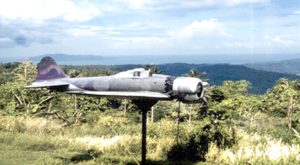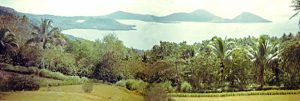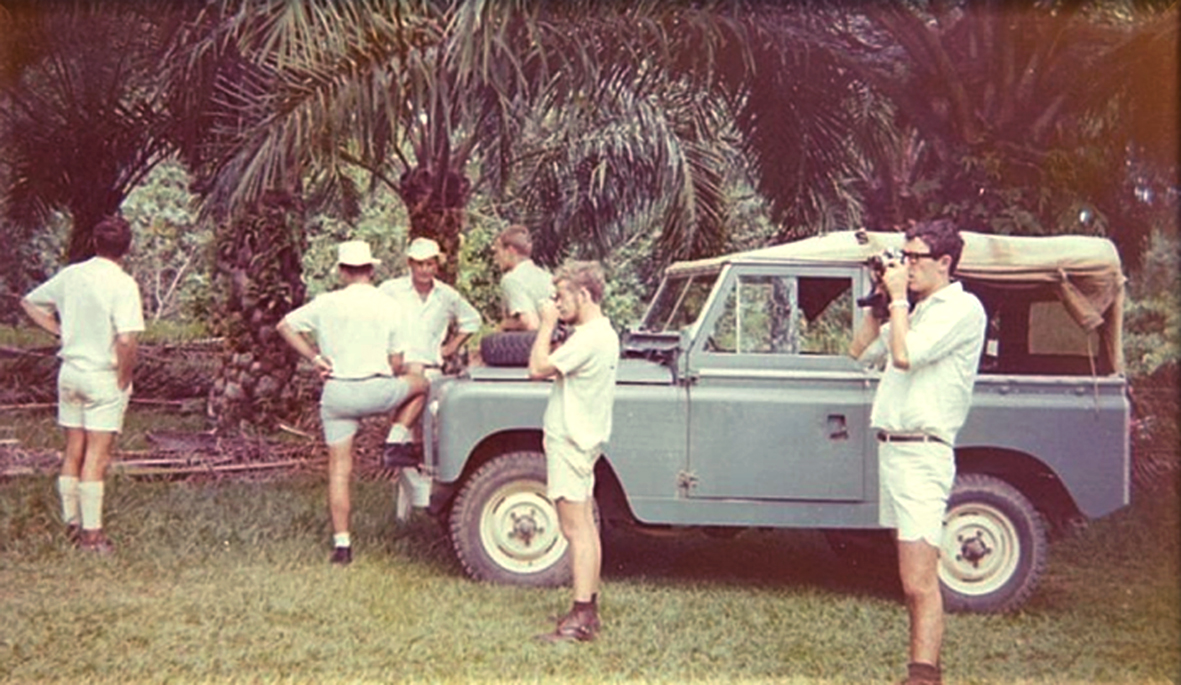Department of Agriculture, Stock & Fisheries, Taliligap, Rabaul Part One
THE GATEWAY FOR NEW RURAL DEVELOPMENT OFFICERS (Didiman) TO THE PNG ISLANDS: Personal Experiences in 1967
By Peter Stace & JW (Bill) Gornall
In October 2023, I received the following email from an old work colleague from my time in Papua New Guinea (PNG).
A contributor to PNG Kundu, he had seen some of my stories in the journal:
Bill Gornall, Wed 25/10/2023 10:36 AM
PNG Days: Hello Peter, my name is Bill Gornall and I wonder if on 23 June 1967, you flew on my flight POM to Rabaul and then on to the Department of Agriculture Stock and Fisheries (DASF) Taliligap for initial ‘information sessions’ on Ag practices in PNG. Please just disregard if I’m barking up the wrong tree here! Cheers, BG.
A huge blast from the past! Of course I remembered the occasion. Is it possible to forget your birthday, your old school, or your first . . . whatever important thing in your life? I remembered Bill because he told me it was his 21st birthday and, in retrospect, both of us were embarking on an experience never to be forgotten: being introduced to the Jewel of PNG – Rabaul.
During the following emails and phone calls old stories were exchanged, and the idea of writing a story about the Department of Agriculture, Stock & Fisheries (DASF) Taliligap, the gateway to the PNG Islands for new Rural Development Officers (RDOs), or didiman, was suggested. So here is an attempt to place the story of DASF Taliligap into the literature of PNG, with the personal experiences in 1967 of myself, Peter Stace and Bill Gornall.
DASF Taliligap
This was an agricultural extension station (Didiman station) for East New Britain. It is on the Burma or Vuruga road, which runs along the escarpment of the caldera making up Rabaul’s Simpson Harbour. It is a few kilometres past the Coastwatchers Lookout and the United Church mission at Malmaluan and is the heart of Tolai country.
Taliligap History
It appears that Taliligap, in one of its historical roles, was an Australian army camp following the Japanese surrender in 1945.
DASF Taliligap had one of the most captivating and unforgettable views of Simpson Harbour and surrounding volcanoes, including Rabalanakaia Crater, Kombiu (The Mother), Toyanumbatir and Turanguna (North and South Daughters), Mount Tavurvur (Matupi Crater) and Vulcan. Arguably, though, DASF Taliligap has the best view of all; not only can you see Rabaul town, the volcanoes and the harbour, on a good day the Duke of York Islands, and New Ireland, could be observed.
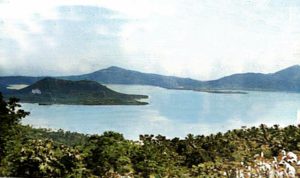
Taliligap, New Britain, September 1945—view of Simpson Harbour with the crater of Vulcan in the foreground. This scene was taken after Australian troops occupied the area following the Japanese surrender (Cain: 2020)
Two points suggest that the land on which DASF Taliligap Agricultural Extension Station sat was a remnant of early German colonisation:
Firstly, the pyramid-shape cement foundations were part of German architecture. (From personal communications with author, Rod Miller, who noticed these foundations under the old bungalow when he visited Taliligap in 2002.)
Secondly, the name didiman is supposed to be a vestige of German times, describing either Dr Beidermann or Mr Dietmann, who were the German curators of Rabaul’s botanical gardens pre-WWI.
These men wanted to boost copra production, and sent people out to Tolai villages to advise and encourage its production. These men were called Diddy’s men, and so the name didiman for agricultural extension officers has passed down through time (Godbold: 2010).
After WWII, DASF Taliligap was the first stop for orientation for some new RDOs. Here was the first step before commencing work before being posted to New Ireland, New Britain, and Bougainville.
There are references in PNG Kundu to the following personnel working out of DASF Taliligap:
Robert Leonard PULSFORD HERE
(Vale, PNG Kundu, d. 22 July 2004, aged 88)
On 1958 Robert Pulsford was at Taliligap on the Gazelle Peninsula where he was in charge of a training centre with a focus on cocoa production. The following two years saw him based in Rabaul as District Agricultural Officer for East New Britain
Barry James BEIL HERE
(Vale, PNG Kundu, September 2023)
Barry’s first posting was at Taliligap in 1957.
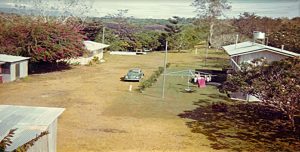
View of DASF Taliligap from the old bungalow. The OIC’s house is on the right, office on the left, with many houses and sheds down from the left (Bill Gornall, 1967)
DASF Taliligap was an active station from 1957 to 1958, and perhaps for some years prior. In 1967 it was the agricultural extension station for the Gazelle Peninsula, as well as most of East New Britain, including out-stations on the Duke of York Islands, Wide Bay and Pomio. When we arrived in 1967, the permanent staff were Rod Henderson (OIC), Jim Parker and Col Briety. Other recruits who arrived around the same time as us were Alan Pretty and Reg Hill. (If we have forgotten anyone, we apologise).
From memory, and Bill’s notes, the tropical agricultural experiences for us raw recruits were with cocoa and coconut production, cocoa marketing, village-intensive livestock projects such as poultry and pigs, and the rudiments of agricultural extension patrol work. Only some of us went on patrol to outlying areas.
Part of our orientation to PNG agriculture was awareness of other agricultural organisations that would help build our knowledge for the didiman job. This included:
The Lowlands Agricultural Experiment Station (LAES), now known as National Agriculture Research Institute (NARI), in Keravat, where agricultural research was conducted with the many potential crops for village and expatriate-run plantations. It was at LAES that work on cocoa breeding and cocoa dieback disease was carried out as well as research on indigenous food crops.
LAES contributed over many years to worldwide research into tropical agriculture of cocoa, coconuts, oil palm, spices and tropical food crops such as taro, tapioca and sweet potatoes. LAES (the oldest research station in PNG) enjoys a prodigious reputation as an agricultural research station.
Kurakakaul Livestock Centre near Rabaul was also on the training agenda for us recruits, to become mindful of livestock industries in the PNG Islands. These industries were essentially pigs and poultry – village-style – although there were attempts to develop cattle projects. Livestock catered for at this facility included horses, pigs, beef cattle and poultry. Staff included Anthony (Tony) Howard as OIC. At Taliligap, introduction to cocoa and coconuts was a high priority, as they were big money earners for village farmers throughout coastal PNG. Traditional food crops were also a major income source.
References:
Cain, Barney 2020. Australian War Memorial (AWM) Available online HERE.
Godbold, KE, Didiman: Australian Agricultural Extension Officers in the Territory of Papua and New Guinea, 1945–1975. Thesis BA Hons (QUT) 2010. Brisbane. Available online HERE.
Part 2 will be published in the next issue of PNG Kundu

